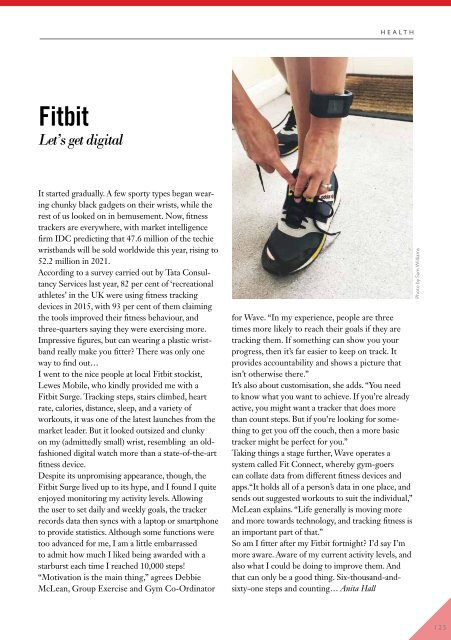You also want an ePaper? Increase the reach of your titles
YUMPU automatically turns print PDFs into web optimized ePapers that Google loves.
HEALTH<br />
Fitbit<br />
Let’s get digital<br />
It started gradually. A few sporty types began wearing<br />
chunky black gadgets on their wrists, while the<br />
rest of us looked on in bemusement. Now, fitness<br />
trackers are everywhere, with market intelligence<br />
firm IDC predicting that 47.6 million of the techie<br />
wristbands will be sold worldwide this year, rising to<br />
52.2 million in 2021.<br />
According to a survey carried out by Tata Consultancy<br />
Services last year, 82 per cent of ‘recreational<br />
athletes’ in the UK were using fitness tracking<br />
devices in 2015, with 93 per cent of them claiming<br />
the tools improved their fitness behaviour, and<br />
three-quarters saying they were exercising more.<br />
Impressive figures, but can wearing a plastic wristband<br />
really make you fitter? There was only one<br />
way to find out…<br />
I went to the nice people at local Fitbit stockist,<br />
<strong>Lewes</strong> Mobile, who kindly provided me with a<br />
Fitbit Surge. Tracking steps, stairs climbed, heart<br />
rate, calories, distance, sleep, and a variety of<br />
workouts, it was one of the latest launches from the<br />
market leader. But it looked outsized and clunky<br />
on my (admittedly small) wrist, resembling an oldfashioned<br />
digital watch more than a state-of-the-art<br />
fitness device.<br />
Despite its unpromising appearance, though, the<br />
Fitbit Surge lived up to its hype, and I found I quite<br />
enjoyed monitoring my activity levels. Allowing<br />
the user to set daily and weekly goals, the tracker<br />
records data then syncs with a laptop or smartphone<br />
to provide statistics. Although some functions were<br />
too advanced for me, I am a little embarrassed<br />
to admit how much I liked being awarded with a<br />
starburst each time I reached 10,000 steps!<br />
“Motivation is the main thing,” agrees Debbie<br />
McLean, Group Exercise and Gym Co-Ordinator<br />
for Wave. “In my experience, people are three<br />
times more likely to reach their goals if they are<br />
tracking them. If something can show you your<br />
progress, then it’s far easier to keep on track. It<br />
provides accountability and shows a picture that<br />
isn’t otherwise there.”<br />
It’s also about customisation, she adds. “You need<br />
to know what you want to achieve. If you’re already<br />
active, you might want a tracker that does more<br />
than count steps. But if you’re looking for something<br />
to get you off the couch, then a more basic<br />
tracker might be perfect for you.”<br />
Taking things a stage further, Wave operates a<br />
system called Fit Connect, whereby gym-goers<br />
can collate data from different fitness devices and<br />
apps.“It holds all of a person’s data in one place, and<br />
sends out suggested workouts to suit the individual,”<br />
McLean explains. “Life generally is moving more<br />
and more towards technology, and tracking fitness is<br />
an important part of that.”<br />
So am I fitter after my Fitbit fortnight? I’d say I’m<br />
more aware. Aware of my current activity levels, and<br />
also what I could be doing to improve them. And<br />
that can only be a good thing. Six-thousand-andsixty-one<br />
steps and counting… Anita Hall<br />
Photo by Sam Williams<br />
125


















